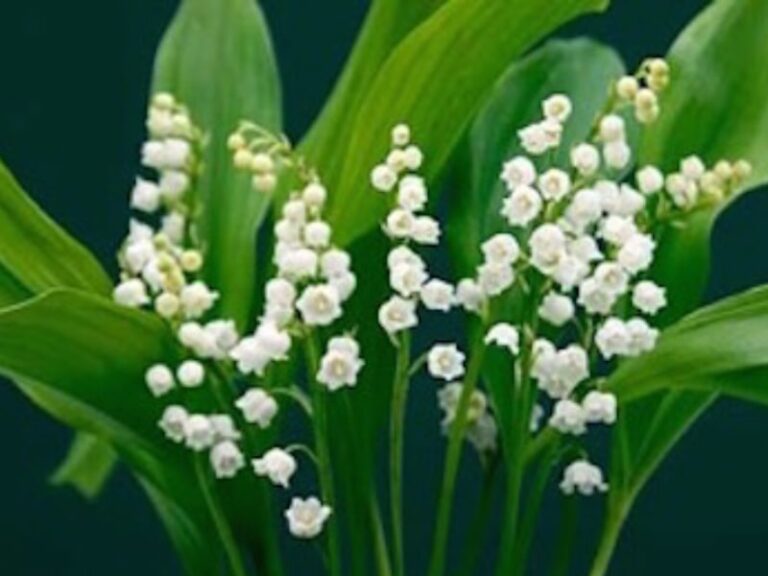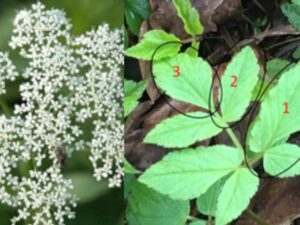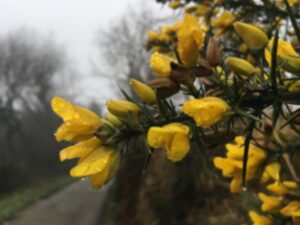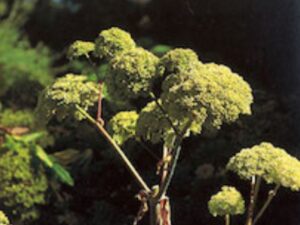Lily of the Valley – Convallaria majalis
My Grandmother had somehow managed to raise a large bed of Lily of the Valley plants along the whole length of this alley. Their angelic fragrance hung in the air, day and night, on fine days or dull days; their abundance was their strength and ruled that space for a few weeks a year. If I was sad, they would cheer my heart and raise my sprits with their wonderful sweet smell and beautiful delicate little flowers. From then on these sweet and powerful plants etched themselves deep into my memory and my soul, a mere whiff of their fragrance transports me back to those very early days of my childhood.
Native to North America, Lily of the Valley is found in dry woodlands in England and Wales, as far north as Dumbarton and East to Inverness but absent from Ireland and Western Britain except where it can sometimes be found as a garden escape. The leaves and flowers are used for herbal medicine but the berries are poisonous.
This is a powerful plant that should not be used by non-professionals and can be toxic in untrained hands. It is the herbalist’s number one choice for congestive heart failure, and helps with water retention and breathing problems associated with this condition.
The generic name Convallaria comes from the older name Lilium convallium due to the pure whiteness of the flowers and was therefore naturally associated with the Virgin Mary in many countries. Long before this it was known in Greek legend, it was found by Apollo and given by him to Aesclepias the Greek physician. An old English name for Lily of the valley is liriconfancy or Our Lady’s tears. They would grow wild in St Leonards Forest, Sussex – supposedly where this saint’s blood was spilt after his fight with the dragon and can still be found today carpeting that forest floor. Its sweet fragrance is said to lead the nightingale from the hedge to his chosen mate.
On writing this I find myself reflecting on those happy childhood days spent with my Granny Alice, gazing into my lovely little Devon garden and wondering – why do I not have any Lily of the Valley plants yet? Note to self – come October, plant many Lily of the Valley as a tribute to Alice Aylin and her green fingers.
Jayne
And finally
Poem kindly written by Nadia Kingsley – find out more about Nadia and her works.
Overheard, in a garden centre near you
Joy: Oh look Matt look! We must buy this pot.
Matt:Looks dead to me
Joy:Well of course it does. But look at the label – Convallaria majalis
Matt:Eh? (looks puzzled)
Joy:Lily of the Valley. You know – white flowers. Plant in partial shade it says, and a woodland plant – perfect for our dingle!
Matt:I know what it is, Joy. Mother had some plastic ones up on the dining room mantel. An abomination. Like everything she touched. I don’t want to be reminded.
Joy:But
Matt:Look, I’ve spoken.
Joy:They’re sweetly scented
Matt:I wouldn’t know about that
Joy:Prefers alkaline soil (pause) Well. That’s no problem – we’ll buy some additives…
Matt:I’ve heard they’re highly poisonous
Joy:You’re making that up
Matt:I’m not!
Joy:It’s what you always do – when you find yourself in a corner.
Matt:I’ll prove it (gets his mobile out)
Joy:(hisses) Not here
Matt:(loudly) Why not?
Joy:Please (holds out her hand, it hangs mid air for a moment then drops) – forget I ever mentioned it
Matt:Here we are. All parts highly poisonous – causes abdo pain, vomiting, blah, blah, blah. What about the grandchildren?
Joy:Herbalists use it – I remember Jayne saying…
Matt: There’s a Pet Poison Helpline
Joy:Tell me – in America?
Matt:And a website called ‘no lilies for cats dot com’. Ah. And this is how I knew
Joy:What? (getting her own phone out)
Matt:That they’re poisonous, keep up. It’s what Walt used – both on Augustus Fring, and that six year old, Brock. Though they first suspected Ricin.
Joy:Why does everything we discuss have to end up back at Breaking Bad? Says here it works like the drug from the foxglove, profoundly effective in the treatment of a failing heart
Matt:Series 4. Episode 13. Title Face Off. Look – there’s the shot – them by Walt’s pool
Joy:Looks nice (leaning over). What do you think?
Matt:Get four, no six. There’s a three for two thingammy on!
Styled on a much better poem by Shauna Robertson Denver ‘77




